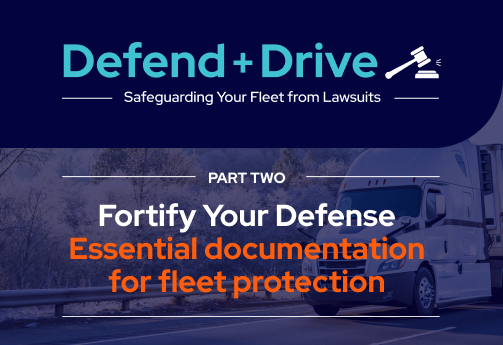Fortify your defense: Essential documentation for fleet protection

To successfully pursue a claim, plaintiff attorneys must establish that the defendant’s negligence led to the accident and subsequent injuries. They will scrutinize the truck driver’s actions, looking for evidence of distracted driving, fatigue, intoxication, speeding, or violation of traffic laws. Attorneys also investigate the trucking company’s practices, such as inadequate training, improper vehicle maintenance, or non-compliance with hours-of-service regulations. By skillfully presenting this evidence, plaintiff attorneys aim to prove that the defendant breached their duty of care, directly causing the accident.
In the first installment, we explored the high-stakes world of fleet lawsuits and how plaintiff attorneys skillfully build their cases against fleets like yours. Today, we’re diving into the practical side of preparing your fleet to withstand potential accidents and lawsuits. Keep reading to uncover the essential documentation you need to protect your fleet.
1. Ensure complete Driver Qualification files
Driver Qualification files are a crucial aspect of maintaining a compliant fleet. The FMCSA clearly outlines what must be included in these files, how frequently they should be updated, and how long they must be retained. Ensure your files are up-to-date and include:
- Annual Motor Vehicle Records (MVR): Review each driver’s driving history at least once every 12 months.
- Complete medical records: Keep up-to-date Medical Examination Reports and Medical Examiner’s Certificates for all drivers, with physical exams every 24 months.
- Employment application: Have a completed and signed application for employment on file for every driver.
- Thorough background checks: Investigate drivers’ employment history for the preceding three years.
- Drug and alcohol testing records: Maintain accurate records of pre-employment drug and alcohol tests.
2. Documentation of driver training
Ongoing driver training is key to nurturing a fleet of skilled drivers. Document your training efforts to demonstrate your commitment to safety.
- Training policies and procedures: Provide copies of your company’s training policies and procedures, outlining requirements and protocols for driver education and training.
- Training program documentation: Keep comprehensive records of the training materials used to educate drivers, including manuals, outlines, syllabi, and other materials.
- Training attendance records: Document driver attendance and participation in training sessions. This can include sign-in sheets or training rosters, which can serve as proof that your company requires and tracks driver participation in ongoing education.
- Training completion certificates: Issue certificates to drivers who successfully complete training modules or courses.
3. Demonstrate diligence in hiring
To disprove the accusation of negligently hiring, supervising, and retaining unqualified drivers, it’s crucial to demonstrate that your fleet has a well-defined hiring policy and clear requirements for driver qualifications. Here are the key considerations:
- Written Hiring Policy: Established guidelines for selecting drivers with a written policy outlining criteria.
- Definitive requirements: Clearly outline requirements based on industry standards and regulations.
- Motor Vehicle Records (MVR) requirements: Conduct thorough MVR (motor vehicle records) checks to assess a driver’s history and violations.
- Insurance carrier involvement: Explain the role of your insurance carrier in the hiring process. While insurance carriers may provide guidance or recommendations, highlight that the ultimate decision on driver qualifications rests with your fleet. Emphasize that your fleet maintains the authority to assess driver qualifications and make informed hiring decisions independently.
- Consistency in qualification standards: Apply consistent qualification standards to all potential drivers. This ensures a fair and objective process for assessing driver qualifications.
- Due diligence in hiring: Highlight comprehensive steps taken during the hiring process to rebut the claim of negligent hiring. This may include verifying employment history, checking references, conducting background checks, drug testing, and ensuring compliance with relevant regulations.
- Driver performance monitoring: Explain systems and processes to monitor driver performance including regular performance evaluations, safety training, monitoring of driving behavior data, and implementing corrective measures when necessary.
4. Establish an adequate safety program
A comprehensive safety program is crucial for protecting your drivers, business, and the general public. Ensure you have the right components in place:
- Clear policies and procedures: Establishing communicate safety expectations for all fleet members.
- Training and education: Provide ongoing training to promote safe driving practices and compliance with regulations.
- Vehicle inspections and maintenance: Conduct regular inspections and maintenance to keep fleet vehicles in optimal condition.
- Embrace safety technologies: Utilize modern safety technologies to enhance driver and vehicle safety.
- Driver performance monitoring: Continuously monitor driver behavior and performance.
- Safety reporting and investigation: Encourage open communication about safety concerns and investigate incidents promptly.
- Continuous improvement and training: Stay updated on industry trends and regulations and provide ongoing training.
- Foster a safety culture: Promote a culture of safety throughout the organization.
5. Vehicle maintenance protocols and records
Proper vehicle maintenance is crucial for disproving negligence. Demonstrate your maintenance practices with solid documentation:
- Vehicle maintenance logs: Keep detailed records of inspections, maintenance, and repairs.
- Maintenance and repair invoices: Save invoices and receipts for maintenance and repair work.
- Maintenance policies and procedures: Establish clear guidelines for vehicle maintenance standards and supervision.
- Communication records: Document all communication with drivers regarding vehicle maintenance.
- Training records: Keep records of any training provided to drivers on vehicle maintenance.
- Driver performance evaluations: Record evaluations related to drivers’ vehicle upkeep responsibilities.
- Vehicle telematics data: Utilize telematics systems data to showcase regular maintenance activities.
By addressing these areas proactively, fleets can better defend themselves against negligence claims and plaintiff attorney’s accusations in the aftermath of an accident.


